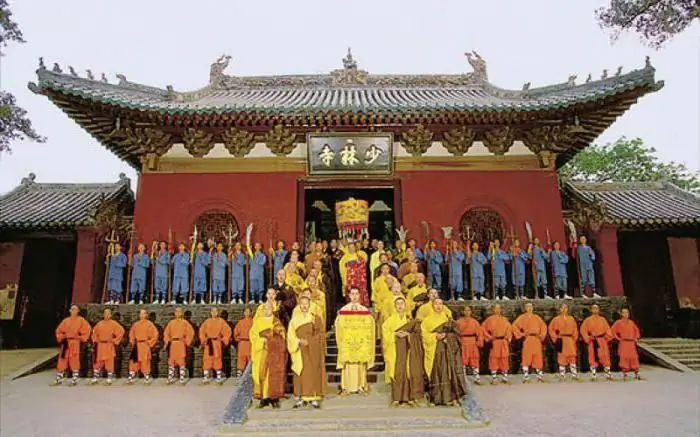- Author Harold Hamphrey [email protected].
- Public 2023-12-17 10:06.
- Last modified 2025-06-01 07:20.
Each city has its own avenues. As a rule, these are the main streets of the city. But let's study this issue from the point of view of the Russian language and urban planning.
Prospect in Russian
Let's start with the fact that "prospect" is a word of foreign origin. This word has Latin roots. The Romans called prospectus the vision of the future or the projection of the future.

In Russian, "prospect" is a polysemantic word. The first and direct meaning of the word is "the wide, straight and longest street in a city or metropolis." In our native language, "prospect" was seen in the 18th century, when Peter the Great was building St. Petersburg. At that time, the straight and wide streets of St. Petersburg were called "perspectives". A little later, the word acquired a modern sound and spelling. The famous Nevsky Prospekt was called 300 years ago as follows: “the promising road leading to the Nevsky Monastery” or “Nevsky Perspective”. Modern writing took shape only towards the end of the 18th century.
Prospect in urban planning
For a city planner, an "avenue" is one of the major and central streets of a city or a street that connects neighboring parts of the same city. The architects endowed the avenuemultiple signs.
Leading signs of the city avenue
Architects and urban planners came to the conclusion that the avenue should have certain features. Let's take a look at them:
- no avenue should have a dead end;
- beginning and/or end of an avenue is only (!) a square, intersection or road junction;
- in any case, the avenue must have a through passage;
- on such a large street, extensive areas for pedestrian crossing should be allocated without affecting the flow of vehicles;
- Public transport - Public transport must operate on the main streets of the city.

If these signs are absent, then, most likely, the name "prospect" was given to the street not according to the rules of urban planning. But the city authorities have the right and will to apply such a name to the street, depending, for example, on toponymic features or traditions.
There are few avenues in millionaire cities. At the same time, for example, in Novosibirsk there are not two or three streets called avenues, but much more:
- Red (6492 meters).
- Dzerzhinsky.
- Dimitrova.
- Marine.
- Komsomolsky.
- Builders.
- University.
- Karl Marx.
Many Novosibirsk residents believe that Krasny Prospekt is the longest street in the city. But it's not. The length of the Red Avenue is 6492 meters. In fact, the longest record holder in Novosibirsk is Pervomaiskaya Street. Herthe length is exactly 7 kilometers.

Prospects of Moscow
In the lexicon of Muscovites, "prospect" appeared a hundred years after the emergence of St. Petersburg. For a very long time they called this word straight alleys in gardens and parks. Since the beginning of the 20th century, Izmailovsky Park has retained the name of the avenues: Elaginsky, Moskovsky, Izmailovsky and Narodny.
The main Moscow highways began to be called "prospects" only from the middle of the 20th century, after 1950.
Today in Moscow there are streets named like that, they are wide and long. Avenues laid near Moscow State University in the south-west of the capital: Vernadsky, Lomonosovsky, Universitetsky and Michurinsky.
Prospects of Petersburg
Flying over St. Petersburg on a plane, you can see its streets. They look like an elegant ornament, which is complemented by picturesque bridges over the sparkling surface of many rivers and canals.
Petersky Prospekt is the history and memory of great people who lived several centuries earlier. Its streets are original heroes of the literary works of Pushkin, Gogol and Dostoevsky. Avenues pass through the historical center of the Northern capital: Nevsky, Voznesensky, Admir alteysky, Grechesky, etc.

Significant street of St. Petersburg
Nevsky Prospekt is the hallmark of the city. In importance, it can only be compared with the Moscow Arbat or the Champs Elysees in Paris. The length of the Neva highway is more than 4 kilometers. It is located from the famous Admir alty to the Alexander Nevsky Lavra. Thislaurel and gave its name to the tract. The opinion that the avenue was named after the main river of St. Petersburg is erroneous. There is no access to the river. But the avenue has several bridges across the Fontanka, Moika, etc. Famous bridges of Nevsky:
- Anichkov.
- Green.
- Kazan.
In 1871, the name "Nevsky Prospekt" was approved by the city authorities. But in 1918 the main thoroughfare of the city was renamed. They called it “25 October Ave.”
The Nevsky tract had to be laid in order to connect the new part of the city with the Admir alty. At this time, the monks paved their way. They built the road for six years. It was difficult, because on the way of the Nevsky route there were swamps and swamps. This road became in demand in a short time. Peter the Great gives the order to build the Police Bridge (Green), as well as to improve the Nevsky Prospect.
Thus, the avenue is the main street of the city, which is quite wide and long. It has designated areas for a pedestrian crossing that do not interfere with the movement of vehicles. Also, public transport should run on the main city highways, which will deliver citizens to the center from remote areas of the city.






